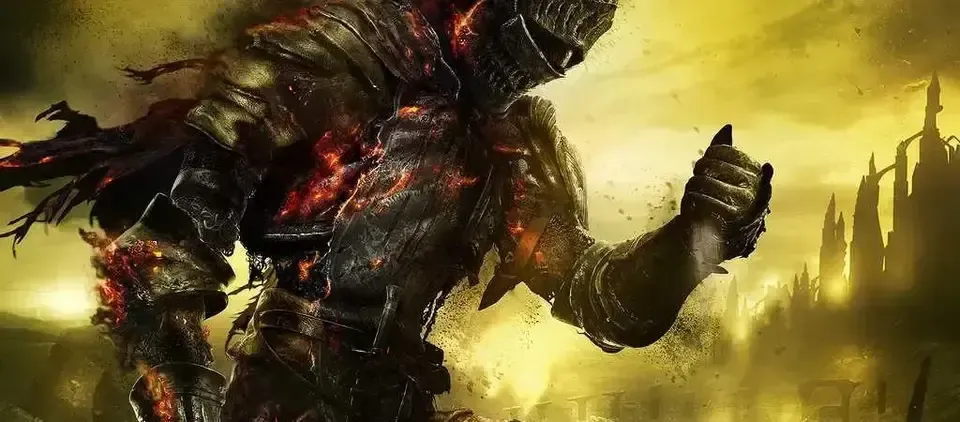
M.L. BLACKBIRD

20 NOVEMBER 2017
DARK SOULS AND INTERACTIVE STORYTELLING
My review of Dark Souls and its peculiar way of narrating stories. Come to read about what I consider the best implementation of an interactive narrative.

It is about time to talk about interactive storytelling, and Dark Souls is probably the best example of it.
I’ve always been interested in games as a way to tell stories because it is the only medium able to be interactive. Whereas books and movies have to be consumed in a passive way, we can compose our own story while we play a game.
Well, that is true just in theory though… so sad!
As a matter of fact, most video games rely on some basic tricks to make you think they are interactive:
- Multiple choices: in this case, the game essentially uses branching paths. Rather than having a single static story, the narrative progresses in multiple ways branching at certain points. The tree of possible outcomes can be as complex as the storytellers want. This is quite an exciting way of writing a story but its interactivity is only apparent. The players will have an active role in the development of the story just by picking the braches at junction points. They cannot choose how they are going to consume the story but it will just be fed to them once a direction is picked.
- Lore books: this happens quite a lot in RPGs. They deliver the side stories and, at times, even the main plot using books within the game. The character is then overloaded by walls of text they can read while playing. I find this way of conveying narrative quite poor and, to be honest, the quality of the writing within the games is often quite low.
Beyond this, games often end-up having quite linear development and, whenever a challenge is surpassed, the story just unfolds in the usual way: dialogue, plain narrative or cutscenes.
Dark Souls does it differently.
Dark Souls
Most people will know this games mostly for its iconic “YOU DIED” moments.
For those who don’t know it, Dark Souls is a dark fantasy RPG set in the land of Lordran. The Gods have moulded the world using the Lord Souls to defeat the dragons and kindle the First Flame thus starting the Age of Fire. Once the flame begins to fade, Lord Gwyn, the most powerful god, sacrifices his soul to the Flame to prolong the Age of Fire. The player has the curse of the Undead – if they die, they will return to life, slowly descending into insanity. They have the mission to take the place of Gwyn and rekindle the Flame once again to avoid the Age of Darkness.
Pretty cool isn’t it?
Interactive Storytelling – the right way

Dark Soul’s main plot is quite simple. What is it then that Dark Souls does differently in delivering interactive narration?
You might not notice it at first, but there is a substantial difference.
Whereas other games will rely on long narrations or cutscenes, Dark Souls uses just items and environment.
Items’ descriptions will contain small details about their origin or previous possessors. Every element in the environment gives hints of why the place is the way it is. Short lines of dialogue with secondary characters complete the set of details the player needs to understand the story.
This also means that if the player doesn’t want to learn anything beyond the main plot they can just do so.
If they want though, they will learn about the huge lore of the game just by sorting items in their inventory. Or even by just walking across the world and fighting an enemy.
A wolf might become aggressive when you get close to a tomb. The armour and weapons of an enemy might be incredibly effective against another one. Someone might call you “sister” for reasons you still don’t understand.
Can we use it in books too?
Now, I know what you are thinking: “Isn’t such a technique just limited to games?”
Well, it might look like so at first. But, have you ever heard anyone saying “Show don’t tell”. I bet you did.
I consider this technique an amazing demonstration of how showing without telling can be incredibly effective. It is possible to do the same in books. Most of the times, as writers, we end up over-delivering details about the lore of our worlds. This is often not useful to further develop our plots.
What we can do instead, it’s hinting at our lore through characters and environment descriptions. We can use the way they talk to each other or the way they behave.
Readers will have to take the hints independently. If they don’t do it, they will just enjoy your main plot, otherwise, they will have an entire world to explore.
Anything you’d fix in Dark Souls?
Well, as usual, I guess!
The main downside of Dark Souls is the same as its best characteristic. So much of the information stays hidden that the player has to dig even to unfold the main plot.
Most people will not only never discover the beauty and depth of the world, but they will never even understand there is an actual story. In that sense, I think that some more telling would have been good for the plot delivery.